PERSPECTIVE: MANAGING INFLATION
Significance of the Topic
- The Reserve Bank of India has recently released the Monetary Policy Committee report.
- The committee in its report has decided to increase the policy repo rate under the liquidity adjustment facility by 40 basis points to 4.40% with immediate effect.
- The committee has also decided to remain accommodative while focusing on withdrawal of accommodation to ensure that inflation remains within the target while supporting growth.
What is Inflation?
- Inflation refers to a sustained increase in the general price level of goods and services in an economy over a period of time.
- It is the rise in the prices of most goods and services of daily or common use, such as food, clothing, housing, recreation, transport, consumer staples, etc.
- Inflation measures the average price change in a basket of commodities and services over time.
- The opposite and rare fall in the price index of this basket of items is called ‘deflation’.
- Inflation is indicative of the decrease in the purchasing power of a unit of a country’s currency. Inflation is measured in percentage.
- Purchasing power is the value of a currency expressed in terms of the number of goods or services that one unit of money can buy. All else being equal, inflation decreases the number of goods or services we would be able to purchase.
- For example, if one had taken one unit of currency to a store in the 1950s, it would have been possible to buy a greater number of items than would be the case today, indicating that the currency had a greater purchasing power in the 1950s.
- If one's monetary income stays the same, but the price level increases, the purchasing power of that income falls.
- Inflation does not always imply falling purchasing power of one's money income since income may rise faster than the price level.
- A higher real income means a higher purchasing power since real income refers to the income adjusted for inflation.
Measures of Inflation in India
- In India, the Ministry of Statistics and Programme Implementation measures inflation.
- There are two main sets of inflation indices for measuring price level changes in India – the Wholesale Price Index (WPI) and the Consumer Price Index (CPI).
- The GDP deflator is also used to measure inflation.
Consumer Price Index
- Consumer Price Index or CPI is an index measuring retail inflation in the economy by collecting the change in prices of most common goods and services used by consumers.
- CPI is calculated for a fixed list of items including food, housing, apparel, transportation, electronics, medical care, education, etc. The price data is collected periodically, and thus, the CPI is used to calculate the inflation levels in an economy.
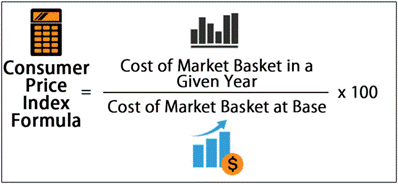
Who maintains Consumer Price Index in India?
- In India, there are four consumer price index numbers, which are calculated, and these are as follows:
- CPI for Industrial Workers (IW)
- CPI for Agricultural Labourers (AL)
- CPI for Rural Labourers (RL) and
- CPI for Urban Non-Manual Employees (UNME).
- While the Ministry of Statistics and Program Implementation collects CPI (UNME) data and compiles it, the remaining three are collected by the Labour Bureau in the Ministry of Labour.
WPI
- Wholesale Price Index, or WPI, measures the changes in the prices of goods sold and traded in bulk by wholesale businesses to other businesses.
Who publishes WPI in India and what does it show?
- The numbers are released by the Economic Advisor in the Ministry of Commerce and Industry.
- An upward surge in the WPI indicates inflationary pressure in the economy and vice versa.
- The quantum of rising in the WPI month after month is used to measure the level of wholesale inflation in the economy.
- Base year: 2011-12. (In the calculation of an index the base year is the year with which the values from other years are compared).
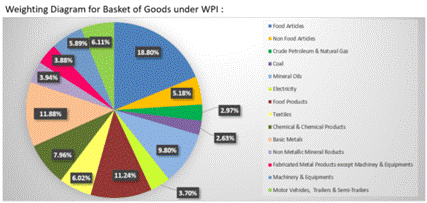
GDP Deflator
- The GDP deflator, also called implicit price deflator, is a measure of inflation.
- It is the ratio of the value of goods and services an economy produces in a particular year at current prices to that of prices that prevailed during the base year.
- This ratio helps show the extent to which the increase in GDP has happened on account of just a rise in prices rather than an increase in output.
- Deflator covers the entire range of goods and services produced in the economy — as against the limited commodity baskets for the wholesale or consumer price indices.
- Hence, it is seen as a more comprehensive measure of inflation.
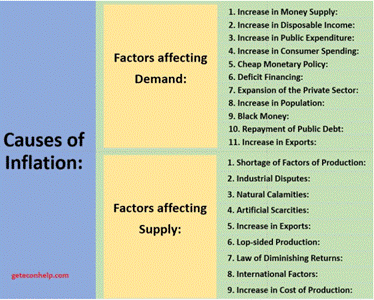
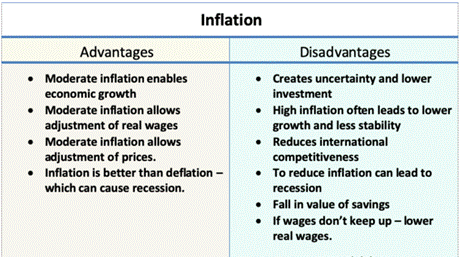
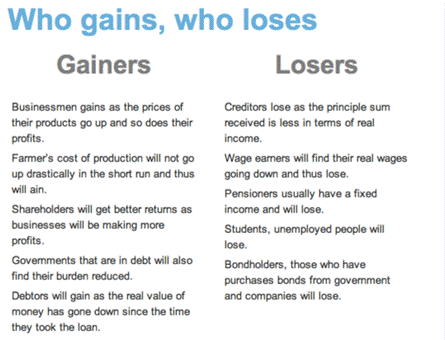
Measures to control Inflation
- Inflation is caused by the failure of aggregate supply to equal the increase in aggregate demand. Inflation can, therefore, be controlled by increasing the supplies of goods and services and reducing money incomes in order to control aggregate demand.
- Some of the important measures to control inflation are as follows:
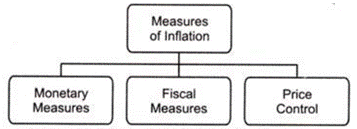
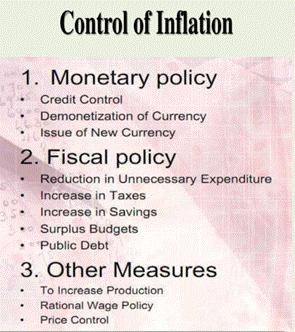
Monetary Measures:
- Monetary measures aim at reducing money incomes.
(a) Credit Control:
- One of the important monetary measures is monetary policy.
- The central bank of the country adopts a number of methods to control the quantity and quality of credit.
- For this purpose, it raises the bank rates, sells securities in the open market, raises the reserve ratio, and adopts a number of selective credit control measures, such as raising margin requirements and regulating consumer credit.
- Monetary policy may not be effective in controlling inflation if inflation is due to cost-push factors. Monetary policy can only be helpful in controlling inflation due to demand-pull factors.
(b) Demonetisation of Currency:
- However, one of the monetary measures is to demonetize currency of higher denominations. Such a measure is usually adopted when there is an abundance of black money in the country.
(c) Issue of New Currency:
- The most extreme monetary measure is the issue of new currency in place of the old currency. Under this system, one new note is exchanged for a number of notes of the old currency.
- The value of bank deposits is also fixed accordingly. Such a measure is adopted when there is an excessive issue of notes and there is hyperinflation in the country.
- It is a very effective measure. But it is inequitable as hurts the small depositors the most.
Fiscal Measures:
- Monetary policy alone is incapable of controlling inflation. It should, therefore, be supplemented by fiscal measures.
- Fiscal measures are highly effective for controlling government expenditure, personal consumption expenditure, and private and public investment.
- The principal fiscal measures are the following:
(a) Reduction in Unnecessary Expenditure:
- The government should reduce unnecessary expenditure on non-development activities in order to curb inflation.
- This will also put a check on private expenditure which is dependent upon government demand for goods and services. But it is not easy to cut government expenditure.
- Though this measure is always welcome it becomes difficult to distinguish between essential and non-essential expenditure.
- Therefore, this measure should be supplemented by taxation.
(b) Increase in Taxes:
- To cut personal consumption expenditure, the rates of personal, corporate and commodity taxes should be raised and even new taxes should be levied, but the rates of taxes should not be so high as to discourage saving, investment and production.
- Rather, the tax system should provide larger incentives to those who save, invest and produce more.
Further, to bring more revenue into the tax net, the government should penalise the tax evaders by imposing heavy fines.
- Such measures are bound to be effective in controlling inflation.
- To increase the supply of goods within the country, the government should reduce import duties and increase export duties.
(c) Increase in Savings:
- Another measure is to increase savings on the part of the people.
- This will tend to reduce disposable income with the people, and hence personal consumption expenditure. But due to the rising cost of living, people are not in a position to save much voluntarily.
- For this purpose, the government should float public loans carrying high rates of interest, start saving schemes with prize money, or lottery for long periods, etc.
- It should also introduce compulsory provident funds, provident fund-cum-pension schemes, etc.
- All such measures increase savings and are likely to be effective in controlling inflation.
(d) Surplus Budgets:
- An important measure is to adopt anti-inflationary budgetary policy.
- For this purpose, the government should give up deficit financing and instead have surplus budgets.
- It means collecting more in revenues and spending less.
(e) Public Debt:
- At the same time, it should stop the repayment of public debt and postpone it to some future date till inflationary pressures are controlled within the economy.
- Instead, the government should borrow more to reduce the money supply to the public.
Like monetary measures, fiscal measures alone cannot help in controlling inflation.
- They should be supplemented by monetary, non-monetary and non-fiscal measures.
Other Measures:
- The other types of measures are those which aim at increasing aggregate supply and reducing aggregate demand directly.
(a) To Increase Production: The following measures should be adopted to increase production:
- One of the foremost measures to control inflation is to increase the production of essential consumer goods like food, clothing, kerosene oil, sugar, vegetable oils, etc.
- If there is a need, raw materials for such products may be imported on a preferential basis to increase the production of essential commodities.
- Efforts should also be made to increase productivity. For this purpose, industrial peace should be maintained through agreements with trade unions, binding them not to resort to strikes for some time.
- The policy of rationalization of industries should be adopted as a long-term measure. Rationalization increases productivity and production of industries through the use of brain, brawn and bullion.
- All possible help in the form of the latest technology, raw materials, financial help, subsidies, etc. should be provided to different consumer goods sectors to increase production.
(b) Rational Wage Policy:
- Another important measure is to adopt a rational wage and income policy. Under hyperinflation, there is a wage-price spiral. To control this, the government should freeze wages, incomes, profits, dividends, bonuses, etc.
- But such a drastic measure can only be adopted for a short period as it is likely to antagonize both workers and industrialists. Therefore, the best course is to link the increase in wages to an increase in productivity.
- This will have a dual effect. It will control wages and at the same time increase productivity, and hence raise the production of goods in the economy.
(c) Price Control:
- Price control and rationing are other measures of direct control to check inflation. Price control means fixing an upper limit for the prices of essential consumer goods.
- They are the maximum prices fixed by law and anybody charging more than these prices is punished by law. But it is difficult to administer price control.
(d) Rationing:
- Rationing aims at distributing consumption of scarce goods so as to make them available to a large number of consumers. It is applied to essential consumer goods such as wheat, rice, sugar, kerosene oil, etc.
- It is meant to stabilize the prices of necessaries and assure distributive justice. But it is very inconvenient for consumers because it leads to queues, artificial shortages, corruption and black marketing.

Why is a moderate rate of inflation good for an economy?
- This acts as a stimulant for the economy by providing it with some momentum.
- When we start expecting sustained price rise, we increase our spending in order to beat inflation and as such this stimulates the growth of the economy.
- As we start spending more, it would increase the profit of the businesses who then start hiring more people or raise the salary of the existing employees or expand.
- All these, in turn, will help in the growth of the economy. Thus, this acts as an incentive for consumers to spend more, businesses to invest, wages to rising and employment to expand thereby helping the economy to grow.
Conclusion
- From the various monetary, fiscal and other measures discussed above, it becomes clear that to control inflation, the government should adopt all measures simultaneously.
- Inflation is like a hydra-headed monster which should be fought by using all the weapons at the command of the government.
https://sansadtv.nic.in/episode/perspective-managing-inflation-07-may-2022
https://timesofindia.indiatimes.com/business/india-business/retail-inflation-rises-to-6-07-in-february/articleshow/90205622.cms
https://epaper.thehindu.com/Home/ShareArticle?OrgId=GOJ9Q499P.1&imageview=0











